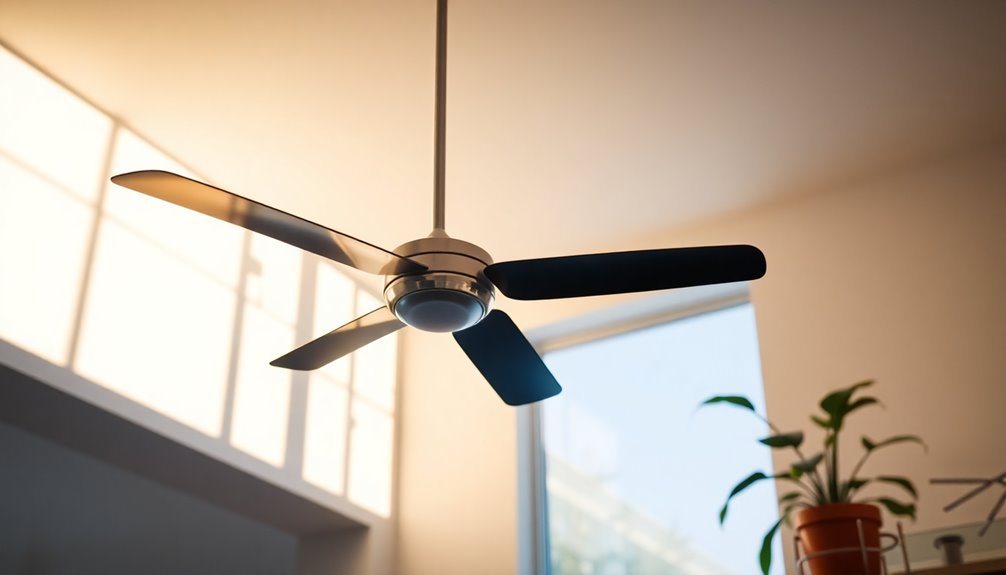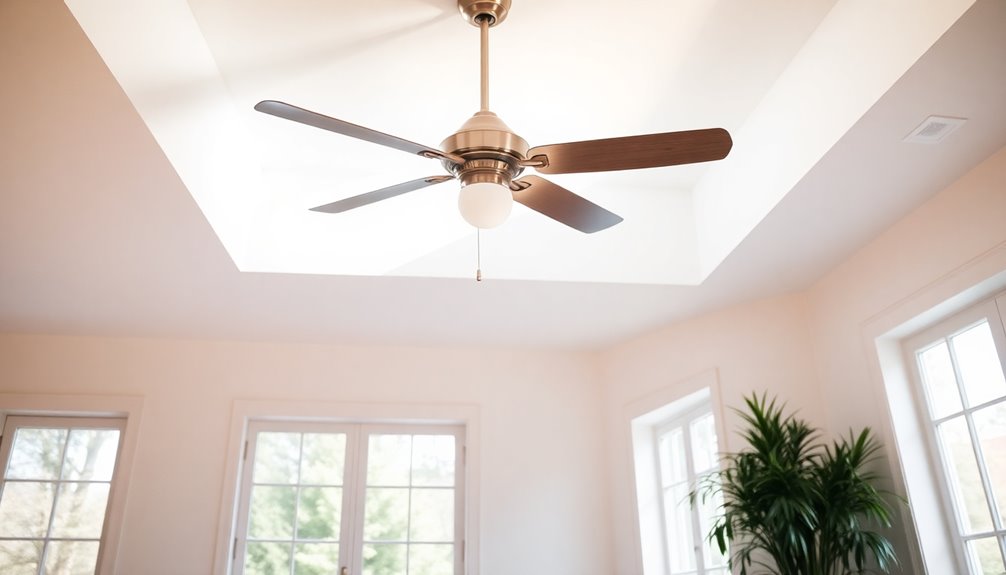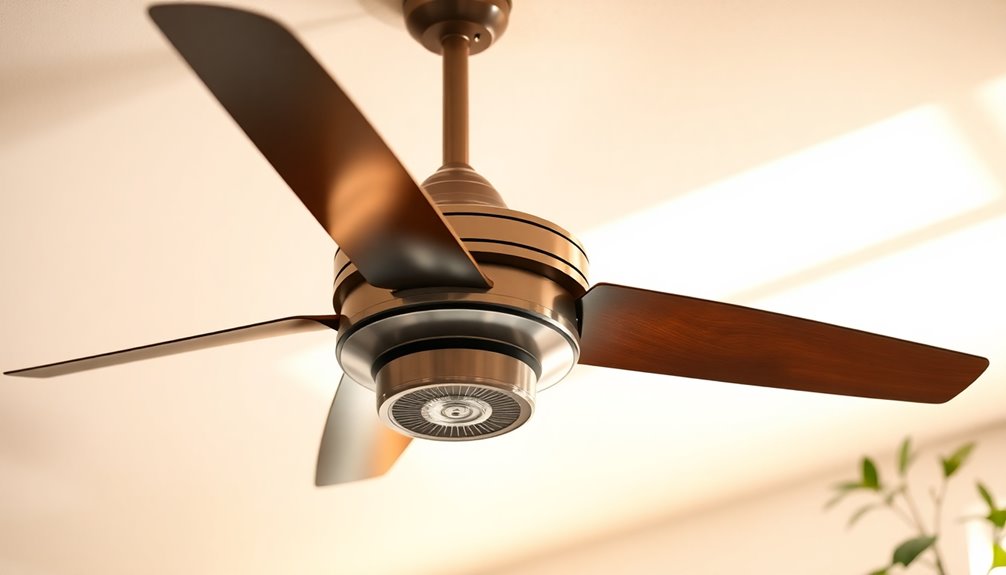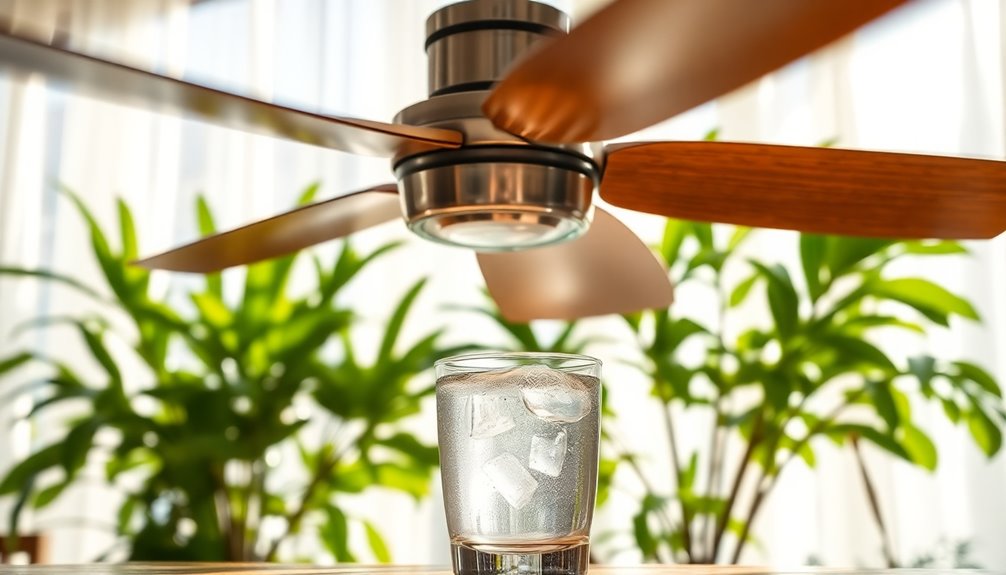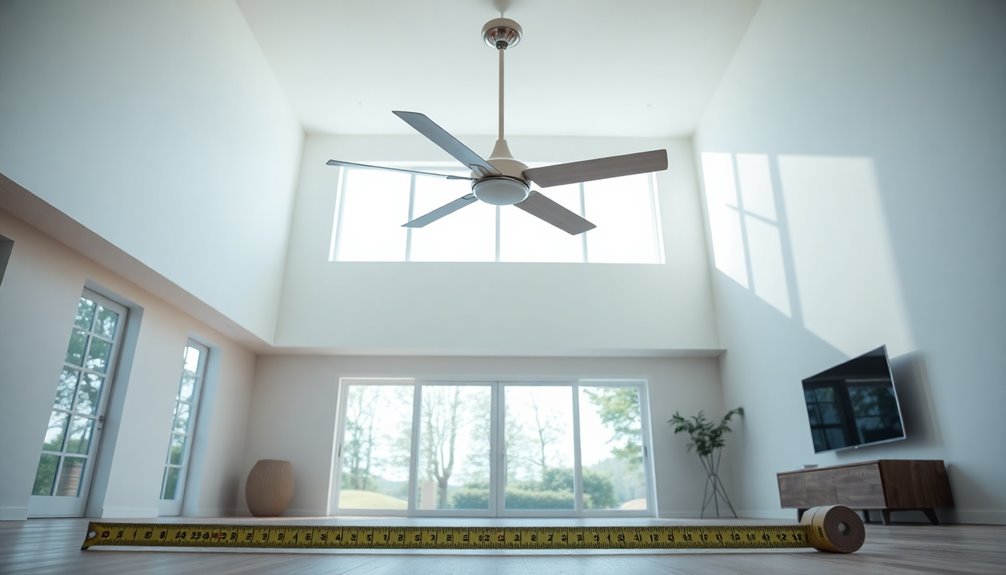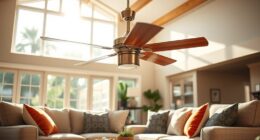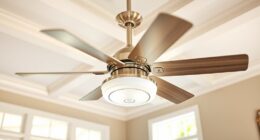In the summer, you want your ceiling fan to turn counterclockwise. This direction creates a cool downdraft, pushing air down and enhancing the wind chill effect, which can make you feel much cooler. By doing this, you can also raise your thermostat by up to 4 degrees without sacrificing comfort. It's an easy way to improve airflow in your space and reduce your reliance on air conditioning, saving on energy costs. Want to optimize your fan's performance even more? There are simple tips and strategies that can elevate your comfort year-round.
Key Takeaways
- In summer, set the ceiling fan to rotate counterclockwise for optimal cooling.
- This direction creates a downdraft effect, pushing cool air downwards for comfort.
- Counterclockwise rotation enhances the wind chill effect, making the room feel cooler.
- Proper fan direction allows you to raise the thermostat by up to 4 degrees without discomfort.
- Ensure the fan is installed at an ideal height of 7-9 feet for effective air circulation.
Importance of Ceiling Fan Direction

The right ceiling fan direction is essential for your comfort during summer months. You want your ceiling fan to rotate counterclockwise, creating a downdraft that pushes cool air downward. This motion enhances air circulation, making you feel cooler without altering the actual room temperature. By achieving this wind chill effect, you can enjoy a revitalizing breeze even on the hottest days.
Proper ceiling fan direction isn't just about comfort; it also plays a significant role in energy savings. When your fan runs counterclockwise, you can raise your thermostat settings by about 4 degrees, leading to potential energy savings of up to 30%. This means less strain on your air conditioning system and more money in your pocket.
For peak cooling efficiency, verify that your fan blades are set at a minimum angle of 12 degrees. This angle maximizes airflow and helps maintain a consistent environment.
Summer Cooling Benefits

Understanding the benefits of using a ceiling fan in summer can enhance your comfort and save you money. When you set your ceiling fan direction to counterclockwise, it creates a downdraft that pushes cooler air downward, resulting in a revitalizing cool breeze. This motion generates a wind chill effect, making you feel considerably cooler without actually lowering the air temperature.
By using your ceiling fan for summer cooling, you can raise your thermostat setting by about 4 degrees, which can lead to impressive energy savings. Running the fan at high speed not only improves airflow but also decreases reliance on air conditioning, potentially reducing energy costs by up to 30%. Additionally, utilizing energy-efficient technology in your cooling systems can further enhance these savings. Many modern ceiling fans are equipped with smart home integration features, allowing you to control them remotely for optimal comfort. Moreover, using a ceiling fan can complement your heat pump system, enhancing overall efficiency during warm months. Smart toilets can similarly contribute to energy efficiency and comfort in your home.
This benefit isn't limited to indoor spaces; using a ceiling fan outdoors in the same counterclockwise direction enhances airflow, making your outdoor areas more pleasant during hot weather. Additionally, many modern fans are designed with energy-efficient motors that promote sustainability while providing effective cooling.
How to Set Fan Direction

To set your ceiling fan direction for summer, start by ensuring it's turned off for safety.
You'll want to adjust the blades to rotate counterclockwise, creating an invigorating downdraft.
Once you've made the change, turn the fan back on and feel the cool breeze to confirm it's set correctly.
Adjusting Fan Settings
Adjust your ceiling fan for summer by ensuring its blades rotate counterclockwise. This ceiling fan direction pushes cool air downward, creating a wind chill effect that enhances your comfort.
To change the direction safely, always turn off the fan first. Then, verify the airflow direction by standing underneath the fan.
If you have a pull chain fan, locate the reversing switch on the fan body and slide it to the opposite direction before turning the fan back on.
For remote-controlled fans, turn off the fan, press and hold the fan button on the remote until the light blinks, then turn the fan back on to adjust the direction.
Smart ceiling fans offer even more convenience. You can adjust fan settings using the SIMPLEconnect app or voice commands once the fan is powered off.
This feature facilitates easy seasonal shifts, enhancing both cooling and heating efficiency. Additionally, using a ceiling fan with high airflow capacity can further improve comfort during hot summer months.
Seasonal Direction Changes
Setting the direction of your ceiling fan for summer is essential for maximizing comfort and energy efficiency.
During the warmer months, you'll want to guarantee your ceiling fan is rotating counterclockwise. This rotation creates a downdraft effect, pushing cool air downward and enhancing your comfort level. As the fan operates in this direction, you'll experience a wind chill effect, making it feel cooler without actually lowering the room temperature.
To further improve the cooling effect, consider increasing the fan speed. Doing so can allow you to raise your thermostat setting by about 4 degrees while still feeling comfortable.
To confirm the ceiling fan direction is correct, stand underneath it; if the air blows directly down, you're all set for summer.
Don't forget to turn off the fan when you leave a room. Fans cool people, not rooms, so this simple action can help you save energy effectively. Additionally, using a ceiling fan in conjunction with energy-efficient models can further enhance your overall energy savings during the summer months.
Optimal Fan Blade Angles

Finding the right blade angle for your ceiling fan is essential for achieving ideal cooling during the summer months. To guarantee optimal cooling, aim for a minimum blade angle of 12 degrees. This angle effectively facilitates air circulation and creates a downdraft, making your space feel cooler.
However, be cautious—angles above 16 degrees can lead to air turbulence, which might disturb loose objects and lower fan efficiency.
If you have a larger room, especially one over 500 square feet, you might need multiple fans with the proper blade angles to maintain adequate air circulation.
Regular maintenance is key; checking and adjusting blade angles can greatly enhance the cooling effect of your fan.
Ceiling Fan Use With Air Conditioning

Using a ceiling fan with your air conditioning can greatly boost your comfort while cutting energy costs.
By rotating counterclockwise, your fan enhances airflow efficiency, allowing you to raise your thermostat by about 4 degrees without feeling any difference.
This combination not only saves you money but also helps your air conditioning unit work more efficiently.
Energy Savings Benefits
Ceiling fans are an excellent companion to air conditioning systems, offering substantial energy savings during the hot summer months. When you use a ceiling fan alongside your air conditioning unit, you can raise your thermostat settings by about 4 degrees without sacrificing comfort. This simple adjustment can lead to energy savings of up to 30%, which considerably reduces your air conditioning costs.
By circulating the cooler air produced by your AC, ceiling fans help maintain a comfortable environment in your home while minimizing the need for constant cooling. This means your AC unit won't have to work as hard, which effectively reduces overall cooling costs. Furthermore, using ceiling fans in tandem with your AC aligns with energy efficiency strategies that aim to lower energy consumption. This is particularly beneficial as HEPA filters can improve indoor air quality, promoting a healthier living space. Additionally, utilizing ceiling fans can enhance heat pump efficiency, contributing to further energy savings in your home. Essential oils like peppermint and eucalyptus can also create a refreshing atmosphere, complementing the cooling effects of your ceiling fan.
To maximize these energy savings, make sure your ceiling fan is set to turn clockwise. This direction helps distribute cooler air more efficiently, enhancing the wind chill effect and allowing you to feel cooler. Additionally, using ceiling fans can complement other energy-saving strategies, such as natural remedies for keeping cool without excessive AC use.
Using ceiling fans not only keeps your home comfortable but also lowers your energy bills during the summer months. With ceiling fans consuming about 50 watts compared to your AC's average of 3,500 watts, it's clear that they're a cost-effective and smart cooling solution.
Enhanced Airflow Efficiency
For ideal airflow efficiency during summer, set your ceiling fan to rotate counterclockwise. This simple adjustment creates a downdraft effect, pushing cool air downwards and considerably enhancing your comfort.
By using the ceiling fan switch to change the fan direction in summer, you can enjoy a more invigorating environment without cranking up the air conditioning.
Consider these benefits of rotating your ceiling fan counterclockwise:
- Cool air is evenly distributed throughout the room.
- Enhanced airflow helps lower the perceived temperature.
- You'll experience energy savings by reducing the need for excessive cooling.
- It can reduce reliance on your air conditioning unit, saving you money.
Complementing Air Conditioning
When the heat of summer sets in, pairing your ceiling fan with air conditioning can make a noticeable difference in comfort and energy efficiency. By ensuring your ceiling fans turn counterclockwise, you create a downdraft that pushes cool air downward. This simple adjustment enhances your comfort while allowing you to set your air conditioning's thermostat a few degrees higher, leading to significant energy savings. Additionally, using air purifiers alongside your cooling systems can further improve indoor air quality and comfort. Home security systems can also be used to monitor energy efficiency when integrated with smart devices. Furthermore, using heat pumps can enhance your home's overall cooling efficiency during the hotter months.
Ceiling fans are a cost-effective supplement to your air conditioning system. While your AC unit may consume around 3,500 watts, ceiling fans only use about 50 watts of power. This means you can enjoy a cooler environment without breaking the bank. Furthermore, implementing energy efficiency evaluations can help identify additional ways to reduce your overall energy consumption.
If you pair ceiling fans with ENERGY STAR-rated air conditioning units, you can achieve an additional 8% in energy savings, optimizing your home energy use. Additionally, regular maintenance of your heat pump system can further enhance efficiency and prolong its lifespan.
Energy Savings in Summer

Maximizing energy savings during the summer months hinges on the proper use of ceiling fans. When you set your ceiling fan to rotate counterclockwise, it creates a revitalizing downdraft that helps you keep cool while reducing reliance on air conditioning.
This simple adjustment can allow you to raise your thermostat by up to 4 degrees without sacrificing comfort, leading to significant energy savings.
Consider these benefits of using a ceiling fan in summer:
- Cooling Effect: Enjoy a breeze that enhances your comfort level.
- Cost Efficiency: Ceiling fans use about 50 watts compared to 3,500 watts for air conditioning units.
- Energy Savings: You could cut energy costs by up to 30% when using fans alongside your AC.
- Improved Air Circulation: Distributes cooler air more effectively throughout the room. Additionally, using ceiling fans can complement the efficiency of heat pumps, leading to even greater energy savings.
Common Misconceptions

You might think that ceiling fans actually cool down a room, but they only create a wind chill effect that helps you feel cooler.
Another common myth is that you should always run your fan on high speed, when a medium setting is often enough for summer comfort. Regular preventive care can enhance the efficiency of your fan, allowing for optimal performance at any speed, just like maintaining proper air purifier maintenance can significantly improve air quality.
Plus, remember to turn off the fan when you leave the room to save energy, since fans only cool people, not spaces. Additionally, it's important to ensure proper air quality in your living spaces, as this can significantly affect your overall comfort level.
Wind Chill Effect
Often misunderstood, the wind chill effect created by ceiling fans in summer can greatly enhance comfort without actually cooling the air. When you set your ceiling fan to rotate counterclockwise, it pushes cooler air downward, making you feel invigoratingly comfortable.
Here's how it works:
- The fan blades spin in a counterclockwise direction.
- Cooler air is circulated downwards, creating a breeze.
- This breeze evaporates moisture from your skin, enhancing your comfort.
- You can raise your thermostat by about 4 degrees, saving on energy costs.
Many people mistakenly think ceiling fans lower air temperature, but they actually create a wind chill effect. This means you feel cooler without changing the room temperature.
Using your ceiling fans effectively can lead to energy savings of up to 30% when combined with your air conditioning system. Understanding this wind chill effect guarantees you maximize your comfort while minimizing energy consumption.
Energy Efficiency Myths
During the hot summer months, misconceptions about ceiling fans and energy efficiency can lead to ineffective cooling strategies. Many folks think running a ceiling fan will lower room temperature, but that's simply not true. Instead, the fan should be spinning to create a wind chill effect that helps you feel cooler, allowing you to raise your thermostat by about 4 degrees without discomfort.
It's also a myth that ceiling fans can replace air conditioning. They work best when used alongside your AC to enhance cooling efficiency and lower your energy bill. Remember, running a fan in an unoccupied room wastes energy; fans cool people, not spaces.
Another common misconception is that fan direction doesn't matter. In the summer, your ceiling fan should turn counterclockwise to create a downdraft, pushing cool air down toward you.
Room-Specific Fan Adjustments

When it comes to optimizing comfort in different rooms, adjusting your ceiling fan's direction can make a significant difference. By setting your ceiling fan to spin counterclockwise during the summer, you'll promote cool air circulation that enhances the overall room feel.
Here's how to tailor your fan's direction for specific spaces:
- High Ceilings: In rooms with high ceilings, counterclockwise rotation helps distribute cool air more effectively.
- Bedrooms: A counterclockwise fan setting can make your bedroom feel more comfortable, allowing you to raise the thermostat by about 4 degrees for energy savings.
- Kitchens: Keep your kitchen cooler while cooking by using the counterclockwise setting, reducing the need for air conditioning.
- Living Rooms: A revitalizing breeze in larger living rooms is achieved with counterclockwise fan motion, improving airflow throughout the space.
Don't forget to switch your fan direction back to clockwise for winter use, allowing warm air to circulate downwards.
With these adjustments, you'll enjoy a more comfortable environment while also saving on energy costs.
Maintenance for Efficiency

To keep your ceiling fan running efficiently, regular maintenance is key. Start by cleaning the blades frequently to remove dust and debris. A clean fan improves airflow and enhances cooling efficiency, helping you save energy in the long run.
Make sure to check that all screws and bolts are tightened to prevent wobbling, which can affect performance and pose safety risks. Confirm your fan hangs at the ideal height of 7-9 feet from the floor with at least 10 inches of clearance between the blades and the ceiling. This allows for effective air circulation.
When installing, use a leveling tool to check the blade angle, aiming for the recommended minimum angle of 12 degrees to maximize airflow.
Don't forget to regularly inspect the motor and electrical components of your fan. Keeping these parts in good condition prolongs the lifespan of your fan and enhances its energy efficiency.
Enhancing Comfort Year-Round

A well-placed ceiling fan can greatly enhance your comfort all year round by maintaining a consistent airflow and temperature in your home.
In the summer, running your ceiling fan counterclockwise creates a revitalizing downdraft that makes the air feel cooler. This simple adjustment can let you raise your thermostat by up to 4 degrees without sacrificing comfort, effectively regulating your indoor climate.
To maximize your ceiling fan's cooling efficiency, consider these tips:
- Confirm the fan rotates counterclockwise during summer.
- Check the blade angle, aiming for a minimum of 12 degrees for ideal airflow.
- Enjoy reduced energy costs, potentially cutting them by up to 30%.
- Experience consistent room temperatures throughout the day.
Frequently Asked Questions
Which Way Should a Ceiling Fan Turn in the Winter?
In winter, you want your ceiling fan to turn clockwise. This direction helps redistribute warm air that rises to the ceiling, creating a more comfortable environment.
Which Way Is the Fan Button Left or Right for Summer?
To adjust your ceiling fan for summer, you'll typically want to move the button or switch to the left.
This setting should make the fan rotate counterclockwise, creating a cool downdraft.
When you're below the fan, the blades will move from the top left to the bottom right.
Regularly checking this guarantees you're maximizing airflow and staying comfortable during those hot days while also saving on energy costs.
Will Turning on a Ceiling Fan in the Summer Lower the Room's Temperature?
Turning on a ceiling fan in the summer won't lower the room's temperature, but it does create a wind chill effect that makes you feel cooler.
The fan circulates air, enhancing comfort without changing the actual temperature. By using a ceiling fan, you might even be able to raise your thermostat a few degrees, saving energy and reducing your cooling costs.
How to Tell Fan Direction?
You might think it's hard to tell a ceiling fan's direction, but it's actually pretty simple.
Stand directly beneath the fan and feel for airflow. If you feel a breeze pushing down on you, it's spinning correctly for cooling. If not, check the blade rotation—when viewed from below, they should move from the top left to the bottom right.
Don't forget to switch off the fan before making any adjustments!
Conclusion
Choosing the right direction for your ceiling fan in summer is like finding the perfect breeze on a hot day. By setting it to spin counterclockwise, you're ensuring invigorating airflow that cools your space and enhances comfort. Remember to adjust the settings for different rooms and keep up with maintenance for maximum efficiency. With these simple tweaks, you can turn your home into a cool oasis, making those sweltering summer days a lot more enjoyable.
